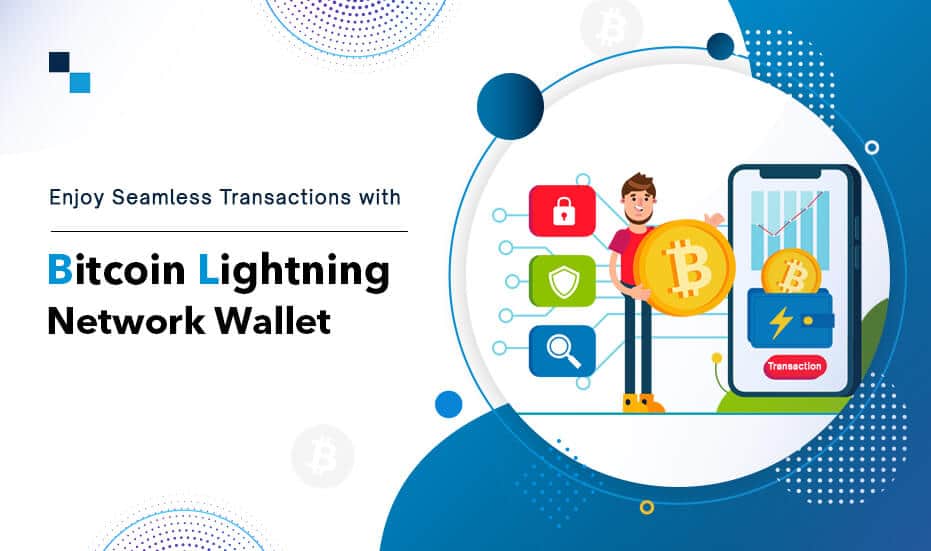
Smart Contract Auditing: Emerging Trends and Real-world Case Studies
July 21, 2023
How ICO Development Solutions Are Shaking Up The Music Industry?
July 25, 2023Bitcoin is a transformative technology that has changed how payments are made. Like other blockchain networks, it has limitations, primarily scalability issues, and transaction fees. Scalability means that the network has a limited capability to handle large amounts of transaction data on its platform in the least time. The network has an average block time of 10 minutes with a transaction processing capacity maximum estimated against an average or median transaction size between 3.3 and 7 transactions per second. Sometimes specific transactions supported by the block have led to network congestion when the transaction volume is high.
The growing network popularity has increased demand for speedier and more efficient transactions. A non-custodial Lightning wallet has been proposed as a feasible solution to combat these issues. The platform sends and receives Bitcoin via. Lightning Network payment channels provide faster and more cost-effective transactions than traditional on-chain Bitcoin transactions.
How Lightning Network Works
Here’s a high-level overview of the Lightning Network:

- Opening a Payment Channel : Two parties who want to perform transactions with one another open a payment channel by creating a multi-signature address. This channel is a secure-off-chain ledger that performs multiple transactions without getting recorded on the main blockchain.
- Performing Off-Chain Transactions : Once the payment channel has been formed, two parties can conduct unlimited off-chain transactions privately and instantly. The payment channel records the transactions and appears on the main blockchain afterward.
- Updating the Channel Balance : Each party can update the channel balance by creating and signing a new transaction that reflects the updated distribution of funds between them. This update can happen as frequently as needed, and the most recent transaction represents the channel’s current state.
- Routing Payments : If two parties within the payment channel want to carry out transactions outside their channel, they can harness the lightning network’s capabilities. Payments can be connected to the network, allowing users to make payments across multiple channels by hopping via intermediate nodes.
- Payment Verification and Settlement : Network transactions require signatures from both parties to prevent illicit activities on the platform. It is the recent transaction that determines the final state of the channel. If there is a mutual agreement on the transaction, the transactions are broadcasted on blockchain to settle the final balances.
- Closing the Channel : Both parties can close the payment channel anytime. The final state is calibrated on the blockchain, and the funds are distributed accordingly.
Unlocking Business Potential : The Benefits of Embracing Lightning Network Wallets
After you have understood the working of lightning network wallets. It’s time to discover the incredible advantages of Lightning Network wallets discussed as follows:
- Improved Payment Efficiency : Lightning network wallets enable enterprises to speed up the transaction process at a reduced cost. This can be advantageous for businesses dealing with a high volume of small-value transactions or needing fast settlement times. Lightning networks are an efficient payment solution that can smooth the business process and enrich the customer experience.
- Cost Effective : Lightning network transactions charge lower fees than on-chain transactions. By obtaining payments via these wallets, businesses can minimize their transaction costs for micropayments. The cost-saving aspect can benefit businesses like e-commerce, gaming, or content streaming that regularly carry out small transactions.
- Enriched Customer Experience : Lightning Network wallets enable instant and seamless payments, enhancing the customer experience. With fast settlement times and low fees, businesses can offer a frictionless payment process, reducing the potential for cart abandonment or customer dissatisfaction. Lightning Network wallet provide customers with a convenient and efficient payment option, increasing customer satisfaction and potentially driving repeat business.
- Cover New Customer Segments : Businesses facing speed, fees, or privacy issues can introduce non-custodial lightning wallets as payment method. This will help them widen their customer base and enter the evolving market.

- Future-Proofing the Business : The Lightning Network represents an innovative solution for scaling blockchain networks. By integrating Lightning Network wallets into their payment infrastructure, businesses can future-proof their operations and stay ahead of the curve. As the Lightning Network continues to gain adoption and matures, businesses that embrace this technology early on can establish themselves as industry leaders and benefit from its potential growth and network effects.
- Enhanced Privacy and Security : The lightning network offers enhanced privacy that is absent in on-chain transactions. This can be beneficial for enterprises primarily concentrating on customer data protection and confidentiality, which will, in turn, boost their trust and loyalty.
Best Bitcoin Lightning Wallets 2023
Below is the complete list of Bitcoin lightning wallets of 2023:
- Breeze Wallet
- Phoenix Wallet
- Wallet of Santoshi
- Blue Wallet
- Muun Bitcoin wallet
- Electrum Wallet
How to Create a Bitcoin Lightning Network Wallet
Developing a Bitcoin lightning network wallet requires sound knowledge of blockchain technology and expertise. The process of Bitcoin Lightning wallet development has been divided into steps that have been discussed in detail as follows:
# Step 1 : Requirement Gathering & Analysis
Define specific features you wish to have in the Lightning network wallet. The requirements stated will be analyzed to deliver a feasible solution. While doing this, focus on user interface, security, platform compatibility, and lightning network protocol implementation.
# Step 2 : Stay Updated with Lightning Network Protocols
Know the ins and outs of lightning network protocols like Lightning network specification(BOLT) and related technologies like payment channels,multi-hop and onion routing. These protocols serve as the basics of lightning network transactions.
# Step 3 : Choose a Development Language & Framework
Choose a programming language and framework that supports lightning network applications. This includes Javascript JavaScript (with libraries like LND or c-lightning), Python (with libraries like pylon-client), or Go (with libraries like btcd).
# Step 4 : Set-Up Bitcoin & Lightning Network Node
Bitcoin and the node must be operated to perform lightning network transactions. Incorporate a feasible implementation like Bitcoin Core for Bitcoin node and Lightning network implementation such as LND or c-lightning for lightning node.
# Step 5 : Include Wallet Functionality
Include core wallet functionalities like account creation, private key management, transaction signing, balance tracking, and lightning network channel management. Make sure that the wallet codebase is secure and powerful.
# Step 6 : Integrate Lightning Network Protocol
Implement the Lightning Network protocol within your wallet application. This involves creating and managing Lightning channels, routing payments, handling invoices, and managing the state of Lightning Network transactions.
# Step 7 : Design User Interface & Development
Create an intuitive and user-friendly interface for your wallet. Consider account management, transaction history, QR code scanning, and Lightning Network-specific features like channel management and payment routing. Once the prototype has been developed, the project moves to development, where it is made live. The team builds a backend infrastructure, which includes setting up servers, databases, and APIs for integrating with blockchain networks and other necessary services.
# Step 8 : Test & Debug
Perform rigorous testing to tailor a fully-functional, reliable, and secure solution. Test the platform against scenarios like opening and closing Lightning channels, routing payments, and handling different Lightning Network transactions. Perform debugging thoroughly and mitigate the issues or vulnerabilities.
# Step 9 : Deploy & Maintain
Prepare the wallet for deployment by packaging it for different platforms (e.g., mobile, web, desktop) based on your target audience. Publish the wallet application and provide ongoing maintenance and support to ensure compatibility with evolving Lightning Network protocols and security updates.

Seize the Future of Payments: Empower Your Business with Antier’s Lightning Network Wallet Solutions
Developing a Bitcoin Lightning Network wallet requires expertise in software development, blockchain technologies, and cryptography. This is when you must consult a Bitcoin wallet development firm like Antier. The platforms developed by the team enable instant payments at lower costs and enhance your user experience. Whether you are looking for integration assistance, customized wallet development, or scaling solutions, get the support you need to get a competitive advantage over others. Don’t miss out on the opportunity to revolutionize your business. Contact a Lightning Network wallet provider and embark on your journey by consulting our subject matter experts today!
We hope that the information presented in this blog has provided you with valuable insights into lightning network wallet development!



